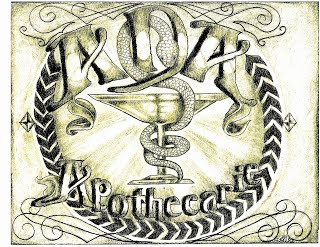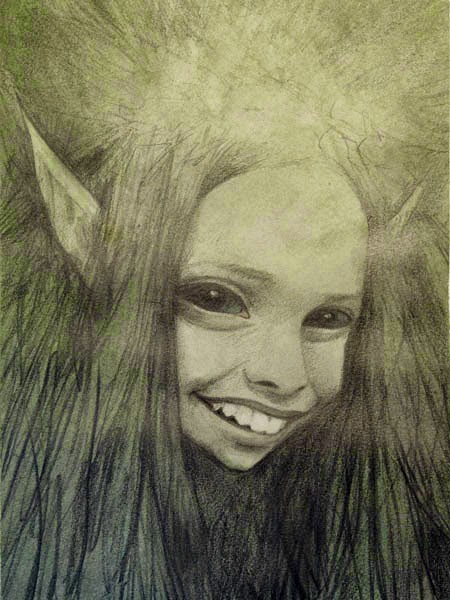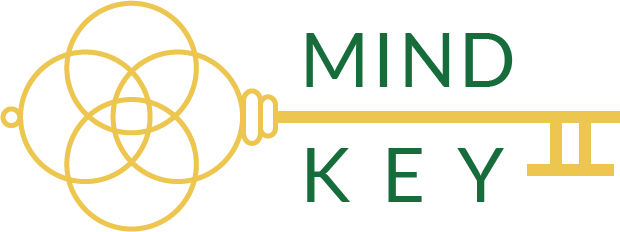
Who are the faeries?
My last faerie blog did its best to define faeries and what they are. The term “faerie” is one I use predominately to discuss a number of different beings – from elementals, to characters and archetypes from folklore around the world that fit into the energetic realm so closely intertwined with Earth.
Why not use the spelling “fairy” people often ask – and my answer is that the term fairy tends to represent more-or-less a pixie-like character with wings. Faery, on the other hand, represents a rather large contingent of energetic, earthy beings, many of whom simply wouldn’t be caught dead in a set of wings or pink tutus.
Faerie artist and tattooist, Scarlet Sinclair, almost never uses “fairy.” “Faerie” speaks to her of the Ancient Race, people of the hills, and nature spirits as well as views that incorporate that energy and folklore.
 |
| Brian Froud’s Tink |
“I use “magick” (as opposed to magic), to separate the concept and practice of magick as a spiritual path and art from what most people know as stage magic and the art of illusions,” Scarlet said. “‘Fairy’ makes me think of Tinkerbell and Disney’s versions of fairytale princesses, etc. To me ‘faerie’ is a way to describe and put faces on the spirits inherent in nature, whether they are tangible things in nature such as rocks or trees or flowers or unseen things in nature such as energy, emotions or magick.”
That’s not to discount the faeries of fairytales either – for they have their place too, as is becoming all the more apparent with the powerful resurgence of fair lore in popular culture over the past half decade.
I also use “Faerie” to describe the realm in which these elemental, folk and archetypical entities exist – separate, yet parallel to ours on the same planet Earth.
“[Faerie] is the place itself, but it’s also the spirit energies that live parallel to this world, closer to nature than we do,” Faerie artist Grace Ng Dung says. “Faerie is the place, but also a sentient energy on the spirit plane that is really closely connected to nature and has a hand in natural forces.”
 Within Faerie there are different hierarchies and Grace said that their systems for classification can be as complicated as humans’. There are the Sidhe and the royals, as well as those we might consider more common. Jessica MacBeth separates those who work closely with humans into groups such as the Singers, Guides and Guardians, and Faery Challengers. I do not hesitate to include beings such as dragons into the realm of faerie, as they often play similar roles and are closely connected to earth via the elements.
Within Faerie there are different hierarchies and Grace said that their systems for classification can be as complicated as humans’. There are the Sidhe and the royals, as well as those we might consider more common. Jessica MacBeth separates those who work closely with humans into groups such as the Singers, Guides and Guardians, and Faery Challengers. I do not hesitate to include beings such as dragons into the realm of faerie, as they often play similar roles and are closely connected to earth via the elements.Additionally there are the elementals who are part of and orchestrate the magic behind each working of nature – water, air, fire and earth. Doreen Virtue believes that even within our own bodies we live with personal elemental faeries that are separate, yet a part of us the same as the essential flora and fauna we need to survive.
 |
| A Brian Froud Faery “Ilbe the Retreiver” |
Fae is another term to describe the inhabitants of Faerie – not any different than faery – except of course, for when it is.
As far as classification goes Norwegian sculptor of the fae, Soso Erlenkamp also believes there are many different faeries, each of whom have taken on different roles.
When asked faeries “role” on earth, Soso said that is about as difficult as asking what human’s role on earth is. There are many different kinds of faeries and how each fae has taken its own role, she said.
“Maybe there is no simple answer to this. If I should pick out a common denominator [for all fae] it is the question of magic. Fae beings, not matter which type, are carriers of magic and without them the world would be a much more boring place,” Soso said.
Learn more about the faeries and their role here tonight on Blog Talk Radio’s “Among the Realms” radio station from 7pm-9pm. I will be guest speaking on faeries as guides. Call in or email your questions to Danielle@MindKey.me and I’ll answer them live.


